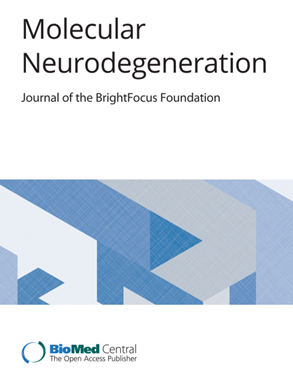Disparate and shared transcriptomic signatures associated with cortical atrophy in genetic behavioral variant frontotemporal degeneration
IF 17.5
1区 医学
Q1 NEUROSCIENCES
引用次数: 0
Abstract
Cortical atrophy is a common manifestation in behavioral variant frontotemporal degeneration (bvFTD), exhibiting spatial heterogeneity across various genetic subgroups, which may be driven by distinct biological mechanisms. We employed an integrative imaging transcriptomics approach to identify both disparate and shared transcriptomic signatures associated with cortical thickness in bvFTD with C9orf72 repeat expansions or pathogenic variants in GRN or MAPT. Functional enrichment analyses were conducted on each gene list significantly associated with cortical thickness. Additionally, we mapped neurotransmitter receptor/transporter density maps to the cortical thickness maps, to uncover different correlation patterns for each genetic form. Furthermore, we examined whether the identified genes were enriched for pathology-related genes by using previously identified genes linked to TDP-43 positive neurons and genes associated with tau pathology. For each genetic form of bvFTD, we identified cortical thickness signatures and gene sets associated with them. The cortical thickness associated genes for GRN-bvFTD were significantly involved in neurotransmitter system and circadian entrainment. The different patterns of spatial correlations between synaptic density and cortical thinning, further confirmed the critical role of neurotransmission and synaptic signaling in shaping brain structure, especially in the GRN-bvFTD group. Furthermore, we observed significant overlap between genes linked to TDP-43 pathology and the gene sets associated with cortical thickness in C9orf72-bvFTD and GRN-bvFTD but not the MAPT-bvFTD group providing specificity for our associations. C9orf72-bvFTD and GRN-bvFTD also shared genes displaying consistent directionality, with those exhibiting either positive or negative correlations with cortical thickness in C9orf72-bvFTD showing the same direction (positive or negative) in GRN-bvFTD. MAPT-bvFTD displayed more pronounced differences in transcriptomic signatures compared to the other two genetic forms. The genes that exhibited significantly positive or negative correlations with cortical thickness in MAPT-bvFTD showed opposing directionality in C9orf72-bvFTD and GRN-bvFTD. Overall, this integrative transcriptomic approach identified several new shared and disparate genes associated with regional vulnerability with increased biological interpretation including overlap with synaptic density maps and pathologically-specific gene expression. These findings illuminated the intricate molecular underpinnings contributing to the heterogeneous nature of disease distribution in bvFTD with distinct genetic backgrounds.遗传行为变异性额颞叶变性与皮质萎缩相关的转录组特征既有差异又有共性
皮层萎缩是行为变异性额颞叶变性(bvFTD)的常见表现,在不同的遗传亚群中表现出空间异质性,这可能是由不同的生物学机制驱动的。我们采用了一种综合成像转录组学方法来鉴定与bvFTD中C9orf72重复扩增或GRN或MAPT致病变异相关的不同和共享的转录组学特征。对与皮质厚度显著相关的基因表进行功能富集分析。此外,我们将神经递质受体/转运体密度图映射到皮层厚度图,以揭示每种遗传形式的不同相关模式。此外,我们通过使用先前鉴定的与TDP-43阳性神经元相关的基因和与tau病理相关的基因来检测鉴定的基因是否富含病理相关基因。对于bvFTD的每种遗传形式,我们确定了皮质厚度特征和与之相关的基因集。GRN-bvFTD的皮质厚度相关基因显著参与神经递质系统和昼夜节律干扰。突触密度与皮质变薄之间不同的空间相关性进一步证实了神经传递和突触信号在塑造大脑结构中的关键作用,特别是在GRN-bvFTD组。此外,我们观察到在C9orf72-bvFTD和GRN-bvFTD中,与TDP-43病理相关的基因和与皮质厚度相关的基因组之间存在显著的重叠,但在MAPT-bvFTD组中没有重叠,这为我们的关联提供了特异性。C9orf72-bvFTD和GRN-bvFTD也有相同的基因,表现出一致的方向性,那些与C9orf72-bvFTD皮层厚度呈正相关或负相关的基因在GRN-bvFTD中表现出相同的方向(正或负)。与其他两种遗传形式相比,MAPT-bvFTD在转录组特征上表现出更明显的差异。在MAPT-bvFTD中与皮质厚度呈显著正相关或负相关的基因在C9orf72-bvFTD和GRN-bvFTD中表现出相反的方向性。总的来说,这种整合转录组学方法确定了与区域易感性相关的几个新的共享和不同的基因,并增加了生物学解释,包括与突触密度图和病理特异性基因表达的重叠。这些发现阐明了复杂的分子基础,有助于具有不同遗传背景的bvFTD疾病分布的异质性。
本文章由计算机程序翻译,如有差异,请以英文原文为准。
求助全文
约1分钟内获得全文
求助全文
来源期刊

Molecular Neurodegeneration
医学-神经科学
CiteScore
23.00
自引率
4.60%
发文量
78
审稿时长
6-12 weeks
期刊介绍:
Molecular Neurodegeneration, an open-access, peer-reviewed journal, comprehensively covers neurodegeneration research at the molecular and cellular levels.
Neurodegenerative diseases, such as Alzheimer's, Parkinson's, Huntington's, and prion diseases, fall under its purview. These disorders, often linked to advanced aging and characterized by varying degrees of dementia, pose a significant public health concern with the growing aging population. Recent strides in understanding the molecular and cellular mechanisms of these neurodegenerative disorders offer valuable insights into their pathogenesis.
 求助内容:
求助内容: 应助结果提醒方式:
应助结果提醒方式:


